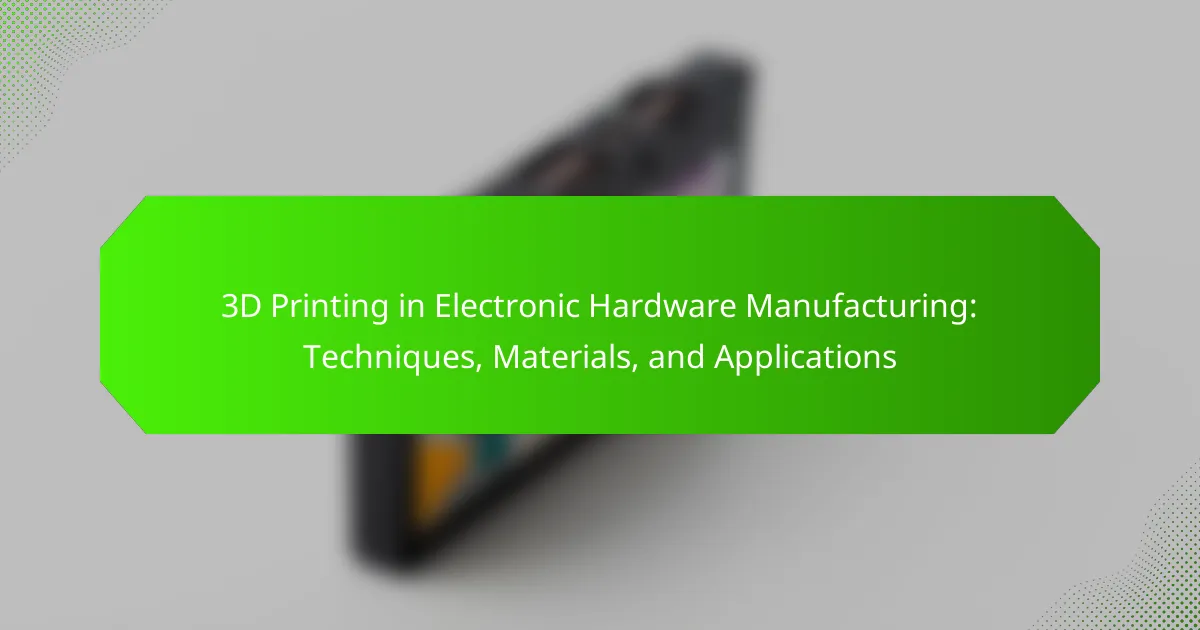PCB assembly processes encompass the methods used to assemble electronic components onto printed circuit boards (PCBs), including material preparation, component placement, soldering, and inspection. Key quality control techniques such as visual inspections, automated optical inspection (AOI), and functional testing ensure the reliability and functionality of the assembled PCBs. Best practices in these processes involve thorough design verification, careful component selection, precise soldering techniques, and regular inspections to enhance overall quality and efficiency. Adhering to industry standards, such as IPC-A-610, further reinforces the consistency and reliability of the final electronic products.

What are PCB Assembly Processes?
PCB assembly processes are the methods used to assemble electronic components onto printed circuit boards (PCBs). These processes include material preparation, component placement, soldering, and inspection. Material preparation involves creating the PCB and preparing components for assembly. Component placement uses automated machines to position components accurately on the board. Soldering typically occurs through reflow or wave soldering methods to secure components. Inspection follows to ensure quality and functionality. These steps are crucial for producing reliable electronic devices.
How do PCB Assembly Processes function?
PCB assembly processes function by integrating electronic components onto a printed circuit board (PCB). The process begins with designing the PCB layout using specialized software. Once the design is complete, the PCB is manufactured, often involving processes like etching and drilling.
Next, components are placed onto the PCB through methods such as surface mount technology (SMT) or through-hole technology. Automated machines typically handle component placement for precision and speed. After placement, soldering is performed to secure the components. This can be done using techniques like reflow soldering for SMT or wave soldering for through-hole components.
Finally, the assembled PCB undergoes testing and inspection to ensure functionality and quality. Automated optical inspection (AOI) and functional testing are common methods used in this phase. Each step in the PCB assembly process is crucial for producing reliable electronic devices.
What are the key steps involved in PCB Assembly Processes?
The key steps involved in PCB assembly processes include design, fabrication, component placement, soldering, and testing. The process begins with designing the PCB layout using specialized software. Next, the PCB is fabricated through etching and drilling techniques. After fabrication, components are placed onto the PCB surface using automated pick-and-place machines. Soldering follows, which can be done through wave soldering or reflow soldering methods. Finally, the assembled PCB undergoes testing to ensure functionality and reliability. Each step is crucial for producing high-quality circuit boards that meet industry standards.
How does each step contribute to the final product?
Each step in PCB assembly processes is crucial for ensuring the quality and functionality of the final product. The design stage establishes the layout and electrical connections, directly influencing performance. Component placement ensures accurate positioning, which is essential for effective soldering. Soldering, whether through wave or reflow methods, creates reliable electrical connections between components and the board. Inspection processes, including automated optical inspection (AOI), identify defects early, reducing the risk of failure. Testing verifies that the assembled PCB meets specifications, ensuring reliability. Finally, packaging protects the assembly during shipping and handling, maintaining integrity until use. Each of these steps is interconnected, contributing to the overall quality and performance of the final PCB product.
What are the different methods of PCB assembly?
The different methods of PCB assembly include through-hole technology, surface mount technology, and hybrid assembly. Through-hole technology involves inserting components into pre-drilled holes on the PCB. This method is known for its durability and is often used for larger components. Surface mount technology places components directly onto the surface of the PCB. This method allows for a more compact design and is widely used in modern electronics. Hybrid assembly combines both through-hole and surface mount techniques. This approach is beneficial for complex PCBs that require a mix of component types. Each method has its specific applications and advantages in PCB manufacturing.
What is the difference between surface mount technology (SMT) and through-hole technology?
Surface mount technology (SMT) involves mounting components directly onto the surface of a printed circuit board (PCB). In contrast, through-hole technology requires components to be inserted into holes drilled in the PCB and soldered on the opposite side. SMT allows for a more compact design and higher component density. This technology supports automated assembly processes, leading to faster production times. Through-hole technology is generally more robust and better suited for components that require physical strength, such as connectors. SMT components are typically smaller and lighter than their through-hole counterparts. As of 2021, SMT has become the dominant method in PCB assembly due to its efficiency and versatility.
How do hybrid assembly methods combine both SMT and through-hole techniques?
Hybrid assembly methods integrate surface mount technology (SMT) and through-hole techniques in PCB assembly. SMT allows for the placement of components directly onto the surface of the PCB. Through-hole techniques involve inserting component leads into drilled holes on the PCB. Hybrid methods leverage the advantages of both techniques. SMT is efficient for high-density components, while through-hole provides mechanical strength for larger components. This combination enhances the reliability and performance of the final product. Hybrid assembly is commonly used in complex electronic devices, ensuring optimal functionality and durability.
What types of equipment are used in PCB assembly?
Various types of equipment are used in PCB assembly. These include pick-and-place machines, which accurately position components on the PCB. Soldering machines, such as wave soldering and reflow ovens, are essential for creating electrical connections. Inspection systems, like AOI (Automated Optical Inspection), ensure quality by detecting defects. Additionally, stencil printers apply solder paste to the PCB. Test equipment, including in-circuit testers, verifies functionality post-assembly. Each of these machines plays a critical role in efficient and accurate PCB assembly processes.
What are the essential machines for SMT assembly?
The essential machines for SMT assembly include pick and place machines, stencil printers, reflow ovens, and inspection systems. Pick and place machines accurately position surface mount components onto PCBs. Stencil printers apply solder paste to the PCB pads before component placement. Reflow ovens heat the solder paste to create strong electrical connections. Inspection systems, such as AOI (Automated Optical Inspection), verify the quality of solder joints and component placement. These machines are critical for ensuring efficient and reliable SMT assembly processes.
How do inspection and testing equipment contribute to quality assurance?
Inspection and testing equipment ensure quality assurance by identifying defects in PCB assembly. These tools measure parameters like electrical performance and physical integrity. They help verify that components meet specified standards. Regular inspections can detect issues early in the production process. Testing equipment, such as Automated Optical Inspection (AOI), evaluates solder joints and component placements. Statistical Process Control (SPC) techniques monitor manufacturing consistency. Data collected from inspections provide insights for continuous improvement. According to IPC standards, effective inspection reduces rework costs and increases reliability.

How is quality controlled in PCB Assembly Processes?
Quality control in PCB assembly processes is managed through various inspection techniques and standards. These techniques include visual inspections, automated optical inspection (AOI), and functional testing. Visual inspections check for obvious defects such as soldering issues or component misalignment. Automated optical inspection uses cameras to detect defects on the PCB surface. Functional testing assesses whether the assembled PCB operates according to specifications. Industry standards like IPC-A-610 provide guidelines for acceptable quality levels. Adhering to these standards ensures consistency and reliability in the final product. Regular audits and process reviews further enhance quality control measures.
What are the common quality control methods used in PCB assembly?
Common quality control methods used in PCB assembly include visual inspection, automated optical inspection (AOI), and functional testing. Visual inspection involves checking for visible defects like solder issues and component misplacements. Automated optical inspection uses cameras to detect defects on the PCB surface. Functional testing assesses the PCB’s performance under operational conditions. These methods help ensure reliability and adherence to specifications. According to IPC standards, these practices are essential for maintaining quality in PCB manufacturing.
How do visual inspections ensure quality in PCB assembly?
Visual inspections ensure quality in PCB assembly by identifying defects and inconsistencies. These inspections involve examining solder joints, component placements, and overall board integrity. Trained inspectors use magnification tools to detect issues not visible to the [censured] eye. Common defects include misaligned components and insufficient solder. Visual inspections can be performed at various stages of assembly. They provide immediate feedback for corrective actions. Research indicates that visual inspection can catch up to 90% of defects if conducted properly. This high detection rate reinforces the importance of visual inspections in maintaining PCB quality.
What role do automated optical inspection (AOI) systems play in quality control?
Automated optical inspection (AOI) systems play a critical role in quality control for PCB assembly. They are designed to detect defects in printed circuit boards during the manufacturing process. AOI systems utilize high-resolution cameras to capture images of the PCB. These images are then analyzed using advanced algorithms to identify discrepancies. Common defects include missing components, incorrect placements, and soldering issues. AOI systems improve defect detection rates significantly, often achieving over 95% accuracy. This technology allows for real-time feedback, enabling immediate corrections. Consequently, AOI systems enhance overall product reliability and reduce manufacturing costs.
Why is quality control critical in PCB assembly?
Quality control is critical in PCB assembly to ensure the reliability and functionality of electronic devices. It helps identify defects early in the manufacturing process. This minimizes costly rework and reduces waste. Effective quality control also enhances customer satisfaction by delivering high-quality products. According to IPC standards, implementing rigorous quality control can reduce failure rates by up to 90%. Consistent quality checks ensure compliance with industry regulations. Overall, quality control safeguards the integrity of the final product, directly impacting performance and longevity.
What impact does quality control have on product reliability?
Quality control significantly enhances product reliability. It ensures that products meet specific standards and specifications. This process involves systematic inspection and testing at various stages of production. Effective quality control identifies defects early, preventing faulty products from reaching consumers. According to a study by the American Society for Quality, companies with robust quality control systems experience a 30% reduction in product failures. This not only increases customer satisfaction but also reduces warranty claims and associated costs. Therefore, quality control is essential for maintaining high reliability in products.
How does effective quality control minimize production costs?
Effective quality control minimizes production costs by reducing defects and waste. When quality control measures are in place, they identify issues early in the manufacturing process. This early detection prevents the need for costly rework or scrapping of defective products. According to a study by the American Society for Quality, companies can save up to 20% of their production costs by implementing robust quality control systems. Additionally, consistent quality improves customer satisfaction and reduces returns, further lowering costs associated with warranty claims and replacements. Overall, effective quality control streamlines operations and enhances efficiency, leading to significant cost savings in production.

What are best practices for PCB Assembly Processes?
Best practices for PCB assembly processes include thorough design verification, careful component selection, and precise soldering techniques. Design verification ensures that the PCB layout meets electrical and mechanical specifications. Using high-quality components reduces the risk of failure during operation. Precise soldering techniques, such as using the right temperature and time settings, enhance joint reliability. Implementing automated assembly processes increases efficiency and consistency. Regular inspection and testing throughout the assembly process identify defects early. Adopting a cleanroom environment minimizes contamination risks. These practices lead to higher quality and reliability in PCB assemblies.
How can manufacturers optimize their PCB assembly processes?
Manufacturers can optimize their PCB assembly processes by implementing automated assembly techniques. Automation reduces human error and increases production speed. Using pick-and-place machines ensures precise component placement. Additionally, manufacturers should adopt surface-mount technology (SMT) for efficient assembly. SMT allows for a higher density of components on PCBs. Regular maintenance of assembly equipment ensures consistent performance and minimizes downtime. Implementing quality control measures, such as automated optical inspection (AOI), helps detect defects early. Streamlining the supply chain for components can also reduce lead times and costs. According to IPC standards, optimizing these processes can lead to a significant increase in yield and overall efficiency.
What strategies can improve efficiency in PCB assembly?
Implementing automation is a key strategy to improve efficiency in PCB assembly. Automation reduces manual errors and speeds up production. Utilizing pick-and-place machines enhances component placement accuracy and speed. Streamlining the workflow minimizes bottlenecks in the assembly line. Employing lean manufacturing principles can eliminate waste and optimize resource use. Regular training for staff ensures they are skilled in the latest techniques and technologies. Investing in high-quality equipment leads to faster and more reliable production. According to a study by IPC, automated processes can increase assembly efficiency by up to 30%.
How can troubleshooting techniques enhance the assembly process?
Troubleshooting techniques enhance the assembly process by identifying and resolving issues quickly. These techniques streamline operations and reduce downtime. For example, root cause analysis helps pinpoint specific problems in the assembly line. Implementing corrective actions prevents recurrence of these issues. Statistical process control monitors variations that may lead to defects. This proactive approach ensures consistent quality in PCB assembly. Data-driven decisions improve overall efficiency and reduce waste. Research has shown that effective troubleshooting can increase productivity by up to 25% in manufacturing settings. Thus, troubleshooting techniques are essential for optimizing the assembly process.
What common challenges do PCB assemblers face?
PCB assemblers face several common challenges. One major challenge is maintaining high quality amid complex designs. As electronic components become smaller and more intricate, the risk of defects increases. Another challenge is managing production costs while ensuring efficiency. PCB assemblers must balance material expenses with labor costs. Additionally, dealing with supply chain disruptions can hinder timely production. Shortages of components or raw materials can lead to delays. Lastly, PCB assemblers often face difficulties in adhering to regulatory standards. Compliance with industry regulations is crucial for market acceptance and safety. These challenges highlight the need for effective processes and quality control in PCB assembly.
How can issues with component placement be resolved?
Issues with component placement can be resolved through several methods. First, ensuring accurate pick-and-place machine calibration is crucial. Regular calibration minimizes misalignment during the assembly process. Second, using advanced optical inspection systems can detect placement errors in real-time. These systems verify component position and orientation before soldering. Third, implementing a robust design for manufacturability (DFM) can prevent placement issues. DFM focuses on designing PCBs that are easier to assemble. Lastly, conducting thorough training for assembly personnel enhances their skills in handling components. Skilled workers are less likely to make placement mistakes. These strategies collectively improve component placement accuracy in PCB assembly.
What are effective solutions for soldering defects?
Effective solutions for soldering defects include improving the soldering process, using quality materials, and implementing regular inspections. Enhancing the soldering process can be achieved by adjusting temperature settings and ensuring proper technique. Utilizing high-quality solder and flux minimizes defects related to material flaws. Regular inspections during and after soldering help identify issues early. Training operators on best practices further reduces the likelihood of defects. Implementing automated soldering systems can enhance consistency and reduce human error. According to IPC standards, maintaining proper environmental conditions is crucial for optimal soldering outcomes.
PCB assembly processes refer to the methods used for assembling electronic components onto printed circuit boards (PCBs), encompassing stages such as design, fabrication, component placement, soldering, and testing. Key assembly methods include surface mount technology (SMT), through-hole technology, and hybrid assembly, each offering distinct advantages based on component requirements. Quality control is critical in these processes, utilizing techniques like visual inspections and automated optical inspection (AOI) to ensure product reliability and adherence to industry standards. The article provides a detailed overview of the equipment used in PCB assembly, common challenges faced, and best practices for optimizing efficiency and quality in manufacturing.



